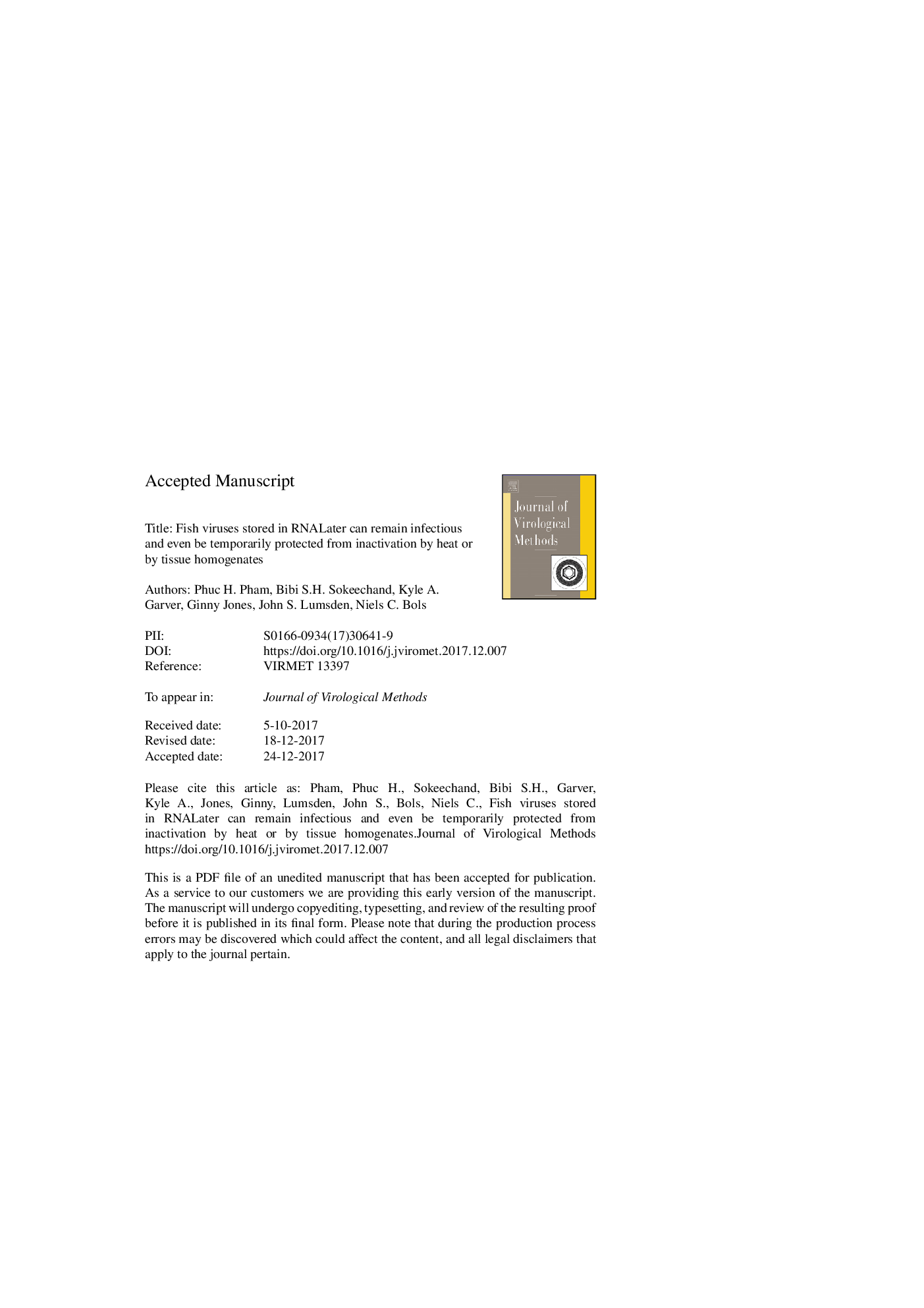| کد مقاله | کد نشریه | سال انتشار | مقاله انگلیسی | نسخه تمام متن |
|---|---|---|---|---|
| 8747123 | 1593424 | 2018 | 23 صفحه PDF | دانلود رایگان |
عنوان انگلیسی مقاله ISI
Fish viruses stored in RNAlater can remain infectious and even be temporarily protected from inactivation by heat or by tissue homogenates
دانلود مقاله + سفارش ترجمه
دانلود مقاله ISI انگلیسی
رایگان برای ایرانیان
موضوعات مرتبط
علوم زیستی و بیوفناوری
ایمنی شناسی و میکروب شناسی
ویروس شناسی
پیش نمایش صفحه اول مقاله

چکیده انگلیسی
RNAlater is a commonly used transport and storage solution for samples collected for fish health investigations, particularly those potentially involving viruses. However, the infectivity of fish viruses after storage in RNAlater have not been determined. Nevertheless, knowledge of pathogen infectivity of preserved samples is crucial for ensuring safe transport and storage protocols. Therefore, the infectivity of three fish RNA viruses in RNAlater was examined at four temperatures: â80â¯Â°C, 4â¯Â°C, room temperature (RT, approximately 22â¯Â°C) and 37â¯Â°C. The viruses were viral hemorrhagic septicemia virus (VHSV), infectious pancreatic necrosis virus (IPNV) and chum salmon reovirus (CSV). Overall, three consistent outcomes were observed. First, all three viruses remained infectious in RNAlater at RT or lower. High log titres of these viruses remained over 30 d of storage in either RNAlater or PBS. Second, RNAlater delayed the thermal inactivation of these viruses when compared to PBS at 37â¯Â°C. For VHSV, the titre remained high in RNAlater after one day of incubation at 37â¯Â°C, but was inactivated to below threshold in PBS over the same period. For IPNV, the titre remained high in RNAlater after 30 d of incubation at 37â¯Â°C, but was inactivated to below threshold in PBS over the same period. For CSV, the titre was slightly higher in RNAlater than PBS at 37â¯Â°C over 7 d, and by day 30, only samples stored in RNAlater proved infectious at titres above the detection threshold. Third, RNAlater delayed the inactivation of these viruses when they were stored together with head kidney homogenates. For VHSV, infectious virus was recovered from samples stored at 4â¯Â°C in RNAlater by day 7 of incubation, whereas it was inactivated to below threshold in PBS over the same period. For both IPNV and CSV, infectious virus was recovered from samples stored at 37â¯Â°C in RNAlater for 7 d, but not so in PBS. In summary, fish viruses can remain infectious and are even temporarily protected from inactivation while in RNAlater. This makes RNAlater a potentially useful solution for the transport of fish viruses. At the same time, precautionary measures must be taken when transporting potentially infectious samples in RNAlater.
ناشر
Database: Elsevier - ScienceDirect (ساینس دایرکت)
Journal: Journal of Virological Methods - Volume 253, March 2018, Pages 31-37
Journal: Journal of Virological Methods - Volume 253, March 2018, Pages 31-37
نویسندگان
Phuc H. Pham, Bibi S.H. Sokeechand, Kyle A. Garver, Ginny Jones, John S. Lumsden, Niels C. Bols,